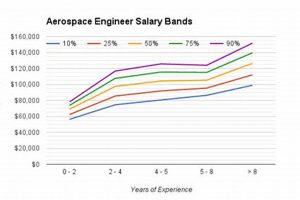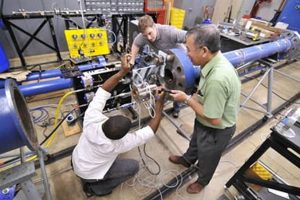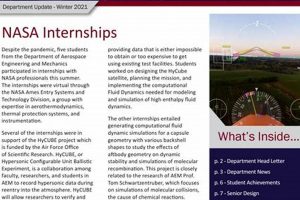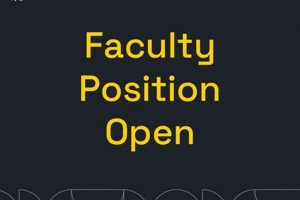Institutions providing undergraduate and graduate programs in the design, development, and testing of aircraft and spacecraft are crucial for the advancement of the aerospace sector. These establishments equip students with the fundamental knowledge and practical skills required to excel in fields such as aerodynamics, propulsion, and structural analysis. Many offer specialized tracks in areas like astronautics, unmanned aerial vehicles, and space exploration.
The presence of these programs is essential for a nation’s technological progress and economic competitiveness. They foster innovation, drive research and development, and produce a workforce capable of addressing complex engineering challenges. Historically, these programs have been instrumental in major advancements in aviation, space travel, and defense technologies, contributing significantly to national security and scientific understanding.
The following sections will delve into key considerations when selecting an appropriate program, including accreditation, curriculum structure, research opportunities, faculty expertise, and career prospects for graduates. Furthermore, this article will provide information on financial aid resources and application strategies to assist prospective students in pursuing their educational goals.
Guidance for Selecting Suitable Institutions
The subsequent points provide objective guidance for individuals navigating the selection process for programs in aeronautical and astronautical engineering. Careful consideration of these factors can significantly influence the quality and relevance of the educational experience.
Tip 1: Evaluate Accreditation Status: Ensure the program holds accreditation from a recognized body, such as ABET. Accreditation signifies adherence to established standards for curriculum quality and program effectiveness, providing assurance of a reputable education.
Tip 2: Examine Curriculum Breadth and Depth: Assess the course offerings to determine if they encompass core aerospace engineering principles, including aerodynamics, propulsion, structures, and control systems. Also, investigate the availability of advanced electives and specialization options within specific areas of interest.
Tip 3: Investigate Research Opportunities: Research participation provides invaluable hands-on experience and enhances understanding of advanced concepts. Inquire about undergraduate research opportunities, faculty research projects, and access to specialized laboratories and equipment.
Tip 4: Assess Faculty Expertise and Experience: Review faculty profiles to ascertain their qualifications, research interests, and industry experience. A strong faculty base with diverse expertise can significantly enrich the learning environment and provide valuable mentorship.
Tip 5: Consider Internship and Co-op Programs: Practical experience in the aerospace industry is highly valuable. Investigate whether the program offers internship or co-operative education opportunities with reputable aerospace companies or government agencies.
Tip 6: Analyze Graduate Employment Statistics: Obtain data on the program’s graduate employment rates and the types of positions held by alumni. This information provides insights into the program’s effectiveness in preparing students for successful careers in the field.
Tip 7: Evaluate Location and Resources: Consider the location of the institution in relation to aerospace industry hubs. Proximity to industry clusters can facilitate networking, internship opportunities, and post-graduation employment prospects. Evaluate available resources, such as libraries, computing facilities, and student support services.
These considerations offer a framework for discerning the strengths and weaknesses of various programs. A thorough investigation will allow potential students to make informed decisions, maximizing their opportunities for academic and professional success.
The article will continue with an exploration of scholarship and financial aid possibilities, aiding in the financial planning aspect of attending institutions with these specialized programs.
1. Accreditation Standards
Accreditation standards serve as a crucial mechanism for ensuring the quality and integrity of educational programs, particularly within specialized fields such as aerospace engineering. For colleges that offer aerospace engineering, adherence to these standards is not merely a procedural requirement but a fundamental indicator of program rigor and relevance. Accreditation, typically conducted by organizations such as ABET (Accreditation Board for Engineering and Technology), involves a thorough evaluation of the program’s curriculum, faculty qualifications, facilities, and overall effectiveness in meeting established educational objectives. Failure to meet these standards can result in the denial or revocation of accreditation, severely impacting the institution’s reputation and the career prospects of its graduates. For example, an aerospace engineering program lacking adequate laboratory facilities or a curriculum that fails to incorporate current industry practices would likely face challenges in obtaining or maintaining accreditation.
The impact of accreditation extends beyond institutional reputation. Accreditation provides assurance to prospective students and employers that the program delivers a high-quality education that prepares graduates for the demands of the aerospace industry. Employers often prioritize graduates from accredited programs, recognizing that they have received a standardized level of training and possess the necessary skills and knowledge to contribute effectively to their organizations. Furthermore, accreditation can be a prerequisite for graduates seeking professional licensure or certification in certain engineering disciplines. Consider the example of a graduate seeking to become a licensed Professional Engineer; completing an accredited aerospace engineering program is often a mandatory step in the licensure process.
In summary, accreditation standards are inextricably linked to the success and credibility of colleges that offer aerospace engineering programs. These standards provide a framework for ensuring program quality, enhancing graduate employability, and maintaining the integrity of the engineering profession. The importance of accreditation should not be underestimated, as it serves as a vital benchmark for students, employers, and the broader academic community in assessing the value and effectiveness of aerospace engineering education.
2. Curriculum Structure
The curriculum structure at institutions providing aerospace engineering programs forms the bedrock upon which students build their knowledge and skills. It is a critical determinant of the quality of education and, subsequently, the preparedness of graduates entering the aerospace sector. A well-designed curriculum encompasses a strategic sequence of courses and learning experiences, ensuring a comprehensive understanding of fundamental principles alongside specialized expertise. A poorly structured curriculum, conversely, can lead to gaps in knowledge, inadequate practical skills, and a diminished ability to address complex engineering challenges. For example, a program that neglects computational methods or omits essential topics like control systems would likely produce graduates ill-equipped for modern aerospace engineering roles.
A robust curriculum integrates theoretical knowledge with practical application through laboratory work, design projects, and potentially, industry internships. Core courses typically cover foundational subjects such as aerodynamics, propulsion, structures, and control systems. Subsequent courses delve into specialized areas such as spacecraft design, propulsion systems, or unmanned aerial vehicles. The sequencing of these courses is vital; prerequisites ensure that students possess the necessary foundational knowledge before tackling advanced topics. Design projects, often culminating in a capstone project, provide opportunities for students to apply their knowledge to real-world engineering problems. For instance, a capstone project might involve designing and testing a small-scale aircraft, requiring students to integrate knowledge from various courses and work collaboratively.
In conclusion, the curriculum structure is an indispensable element in the effectiveness of colleges that offer aerospace engineering. Its organization, content, and integration of practical experience directly influence the quality of graduates and their capacity to contribute to the aerospace industry. Challenges lie in keeping the curriculum updated with rapid technological advancements and ensuring sufficient resources for hands-on learning. Understanding the importance of a well-structured curriculum empowers prospective students to make informed decisions about their education and future career paths in aerospace engineering.
3. Research Opportunities
The availability of research opportunities within institutions is a critical determinant of the quality of aerospace engineering education. These opportunities extend beyond textbook learning, enabling students to engage in hands-on exploration of advanced concepts and technologies. A direct correlation exists between the robustness of research programs and the caliber of graduates produced. Exposure to research fosters critical thinking, problem-solving skills, and innovation, which are highly valued in the aerospace sector. Institutions with strong research initiatives often attract top faculty, creating a stimulating intellectual environment for students. For example, involvement in a project focused on developing new propulsion systems allows students to apply theoretical knowledge to real-world challenges, gaining practical experience that is directly transferable to industry positions. The presence of such opportunities serves as a significant indicator of an institution’s commitment to advancing aerospace engineering knowledge and preparing students for leadership roles.
Research activities at these institutions also provide valuable connections to industry and government agencies. Many universities partner with companies like Boeing, Lockheed Martin, or NASA on research projects, offering students internships and potential employment opportunities. These collaborations provide access to cutting-edge technology and expertise, enriching the educational experience and enhancing career prospects. For example, students involved in research related to autonomous aerial vehicles might have the chance to work alongside engineers from a leading defense contractor, gaining exposure to industry best practices and potentially securing a job after graduation. Furthermore, research publications and presentations at conferences provide avenues for students to showcase their work and network with professionals in the field. The outcomes of these research efforts often contribute to advancements in aerospace technology, ranging from improved aircraft designs to more efficient satellite systems, demonstrating the practical applications and broader impact of these endeavors.
In summary, research opportunities are an indispensable component of quality aerospace engineering programs. They cultivate essential skills, facilitate industry connections, and drive innovation within the field. Challenges include securing adequate funding for research projects and providing sufficient mentorship to guide student researchers. However, the benefits of robust research programs far outweigh these challenges, positioning institutions offering such opportunities as leaders in aerospace engineering education and research. The integration of research into the curriculum represents a commitment to producing well-rounded engineers equipped to tackle the complex challenges of the 21st-century aerospace industry.
4. Faculty Expertise
The proficiency and experience of the faculty at institutions offering aerospace engineering programs are paramount in shaping the educational experience and preparing students for successful careers. The quality of instruction, research opportunities, and mentorship provided are directly correlated to the expertise of the teaching staff. The presence of accomplished faculty members distinguishes leading programs and attracts high-caliber students.
- Research Credentials and Publications
Faculty expertise is demonstrable through research publications, conference presentations, and external funding secured for research projects. Professors who actively contribute to the body of aerospace engineering knowledge are more likely to integrate cutting-edge concepts into their teaching. For example, a faculty member leading research on advanced composite materials for aircraft structures can provide students with firsthand insights into the latest developments in this field, enriching their understanding beyond theoretical concepts.
- Industry Experience and Connections
Faculty members with prior industry experience bring practical insights into the classroom, bridging the gap between academic theory and real-world applications. Former engineers from aerospace companies, government agencies, or research laboratories can offer students valuable perspectives on industry challenges, design processes, and project management. These faculty members often possess established connections within the aerospace sector, facilitating internships and employment opportunities for their students. For instance, a professor who previously worked at NASA might be able to connect students with research internships at a NASA center.
- Terminal Degrees and Specializations
Faculty qualifications, particularly the attainment of terminal degrees (e.g., Ph.D.) in specialized areas of aerospace engineering, are essential for delivering high-quality instruction. Professors with expertise in diverse areas, such as aerodynamics, propulsion, structures, or control systems, ensure a comprehensive curriculum covering the breadth of the field. Specializations align with industry needs and research trends. A professor with a Ph.D. in hypersonics, for instance, could offer specialized courses and research opportunities related to high-speed flight vehicles.
- Teaching Effectiveness and Mentorship
Effective teaching skills and mentorship capabilities are crucial aspects of faculty expertise. Professors who can clearly articulate complex concepts, engage students in active learning, and provide personalized guidance are essential for student success. Mentorship from experienced faculty members can help students navigate their academic and career paths, providing advice on course selection, research opportunities, and professional development. A faculty member who dedicates time to mentoring students on their senior design projects, for example, can significantly enhance their learning experience and prepare them for future engineering roles.
The collective expertise of the faculty at any program shapes the quality of the institution’s learning environment. Institutions prioritizing faculty development and research contributions demonstrate commitment to delivering relevant aerospace programs, ultimately impacting career prospects for its graduates. The combination of academic credentials, industry experiences, and effective teaching practices constitutes a competitive educational environment.
5. Internship Programs
Institutions providing aerospace engineering programs recognize the critical role internship programs play in bridging the gap between academic learning and professional practice. These programs offer students structured opportunities to apply theoretical knowledge in real-world settings, contributing to their technical skills and professional development.
- Practical Application of Knowledge
Internship programs allow students to apply the concepts learned in the classroom to actual engineering projects. For example, an intern at Boeing might work on designing components for a new aircraft, gaining hands-on experience in structural analysis and CAD software. This direct application reinforces theoretical understanding and fosters a deeper comprehension of engineering principles.
- Industry Exposure and Networking
Internships provide students with exposure to the aerospace industry’s culture, work environment, and professional practices. Students build connections with engineers and other professionals, expanding their network and gaining insights into career paths. This networking can be invaluable for future job prospects.
- Skill Development and Resume Enhancement
Through internships, students develop technical skills specific to the aerospace field, such as software proficiency, data analysis, and project management. These experiences enhance their resumes, making them more competitive candidates for full-time positions upon graduation. Successful completion of an internship at a reputable aerospace company signals competence and preparedness to potential employers.
- Career Exploration and Specialization
Internship programs allow students to explore different areas of aerospace engineering, such as aerodynamics, propulsion, or avionics, helping them identify their interests and strengths. This exploration can guide their course selection and specialization choices within their academic program. For example, an internship focused on rocket propulsion might inspire a student to pursue a graduate degree in that area.
The integration of internship programs with academic coursework in aerospace engineering programs is vital for producing well-rounded graduates who are prepared to enter the workforce. Institutions with strong industry connections and well-structured internship opportunities provide a distinct advantage to their students, enhancing their career prospects and contributing to the overall advancement of the aerospace sector.
6. Graduate Outcomes
Graduate outcomes represent a critical metric for evaluating the efficacy of colleges that offer aerospace engineering programs. They reflect the success of an institution in preparing students for entry into the aerospace workforce or for advanced studies. Assessing these outcomes provides insights into the program’s curriculum relevance, faculty effectiveness, and overall alignment with industry demands.
- Employment Rates
Employment rates among recent aerospace engineering graduates serve as a primary indicator of program success. High employment rates suggest that the curriculum is effectively preparing students for the job market and that employers value the skills and knowledge acquired. Factors influencing employment rates include the demand for aerospace engineers, the quality of the program’s career services, and the reputation of the institution. For instance, graduates from a program with strong industry connections and a focus on emerging technologies may experience higher employment rates.
- Salary Levels
Salary levels achieved by graduates reflect the value placed on their skills and knowledge in the job market. Higher starting salaries may indicate a program’s emphasis on high-demand skills, such as systems engineering or advanced simulation techniques. Salary data can also provide insights into regional variations in employment opportunities and the relative competitiveness of graduates from different institutions. Graduates from top-tier programs in high-cost-of-living areas often command higher salaries.
- Placement in Relevant Roles
Placement in relevant aerospace engineering roles is a key indicator of a program’s ability to align its curriculum with industry needs. The percentage of graduates securing positions directly related to aerospace engineering, such as design engineering, research and development, or flight testing, reflects the program’s effectiveness in preparing students for specialized careers. Tracking placement data can reveal trends in the types of roles available and the skills most sought after by employers. A program with a high placement rate in specialized areas like space systems or autonomous vehicles suggests a strong focus on these emerging fields.
- Admission to Graduate Programs
The proportion of graduates accepted into advanced degree programs in aerospace engineering or related fields serves as a measure of the program’s success in preparing students for further academic pursuits. High acceptance rates into competitive graduate programs indicate that the undergraduate curriculum provides a solid foundation for advanced study and research. Factors influencing admission rates include the program’s research opportunities, the quality of faculty mentorship, and the rigor of the coursework. A program with a strong emphasis on research and a track record of producing successful graduate students may attract more applicants to top-tier graduate programs.
In summary, graduate outcomes offer a multifaceted perspective on the efficacy of colleges that offer aerospace engineering programs. They encompass employment rates, salary levels, placement in relevant roles, and admission to graduate programs. A comprehensive analysis of these outcomes provides valuable insights for prospective students, current students, faculty, and employers in assessing the value and relevance of aerospace engineering education. Institutions that prioritize graduate outcomes and continuously strive to improve their programs contribute significantly to the advancement of the aerospace field.
Frequently Asked Questions Regarding Aerospace Engineering Programs
This section addresses common inquiries concerning aerospace engineering programs at the university level. The following questions and answers aim to provide clarity and guidance for prospective students and their families.
Question 1: What prerequisites are essential for admission into an aerospace engineering program?
Successful applicants typically possess a strong foundation in mathematics (calculus, differential equations, linear algebra) and physics (mechanics, electromagnetism). A background in chemistry and computer science is also beneficial. Many institutions require standardized test scores, such as the SAT or ACT, and a competitive GPA. Specific requirements may vary by institution.
Question 2: How does ABET accreditation impact the value of an aerospace engineering degree?
ABET accreditation signifies that a program meets established quality standards for engineering education. Employers frequently prioritize graduates from ABET-accredited programs, as it ensures a certain level of competence and preparedness. Furthermore, graduation from an ABET-accredited program is often a prerequisite for professional licensure.
Question 3: What are the key differences between aeronautical and astronautical engineering specializations?
Aeronautical engineering focuses on the design, development, and operation of aircraft within the Earth’s atmosphere. Astronautical engineering, on the other hand, deals with the design, development, and operation of spacecraft and related technologies for use in outer space. While there is overlap in core principles, the specializations diverge in terms of specific applications and technical challenges.
Question 4: What types of career paths are available to graduates with an aerospace engineering degree?
Aerospace engineering graduates pursue a wide range of career paths in industries such as aerospace manufacturing, defense, government research, and consulting. Common roles include design engineer, test engineer, systems engineer, project manager, and research scientist. Opportunities also exist in related fields such as mechanical engineering, electrical engineering, and software development.
Question 5: What role does research play in an aerospace engineering program, and how can students get involved?
Research is a vital component of many aerospace engineering programs. It provides opportunities for students to apply theoretical knowledge to real-world problems and develop advanced skills. Students can get involved in research through undergraduate research programs, independent study projects, and participation in faculty-led research labs. These experiences can enhance their resumes and prepare them for graduate studies or research-oriented careers.
Question 6: What financial aid options are available to students pursuing aerospace engineering degrees?
Financial aid options include scholarships, grants, loans, and work-study programs. Scholarships may be merit-based or need-based and can be offered by the institution, government agencies, or private organizations. Grants are typically need-based and do not require repayment. Loans must be repaid with interest. Work-study programs allow students to earn money through part-time employment on campus.
These questions and answers provide a foundational understanding of aerospace engineering programs. Further research and consultation with academic advisors are encouraged to make informed decisions.
The subsequent section will delve into resources available for continued learning and professional development in the aerospace engineering field.
Conclusion
The foregoing exploration highlights the key attributes and considerations associated with institutions specializing in aerospace engineering programs. Accreditation, curriculum rigor, research opportunities, faculty expertise, internship availability, and graduate outcomes are crucial factors that define program quality and contribute to the preparedness of future engineers. Careful evaluation of these elements enables prospective students to make informed decisions, maximizing their potential for success in this demanding field.
The selection of an appropriate academic path is an investment in future innovation and technological advancement. Institutions offering comprehensive aerospace engineering education serve as vital hubs for cultivating talent and driving progress within the industry. Continued dedication to academic excellence, coupled with collaboration between academia and industry, will ensure a robust pipeline of qualified professionals capable of addressing the evolving challenges of aerospace engineering.







